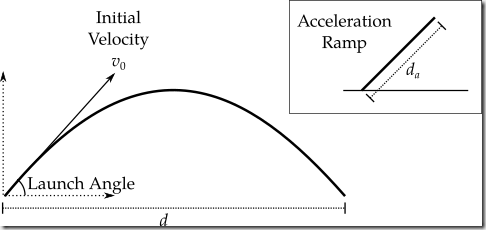School, from our house as the crow flies, is 5.73 km. If we neglect air resistance and deal strictly with ballistic flight then we can materialize a wonderful fantasy. Starting in the backyard, extending over the top of the house, is a launch-o-rocket, a rail-like launcher that accelerates the school-bound student until he or she can cruise over the city and arrive without bother of traffic. Our charter is to find the acceleration of the student from the launch-o-rocket.
Finding the Initial Velocity
We rely on the well-known fact that the maximum distance in a throw occurs when the departure angle is 45°. The vertical speed and the horizontal speed are equal. We denote these two identical speeds as $s$. Since distance is time multiplied by speed, the distance from home to school $d$ is
$$ d = t\cdot s.$$
We know the distance $d = $ 5.73 km.
Turning to the vertical speed, the student departs the launch-o-rocket with vertical speed $s$, but is immediately subject to gravitational acceleration. Since the student’s upward flight is exactly matched by his or her downward flight. Because the flight is matched, the student spends $t/2$ time rising and $t/2$ time descending. Since the student has no vertical speed at the top, we know that his or her speed is
$$ s = g\frac{t}{2},$$
where $g$ is the gravitational acceleration 9.8 m/s2.
Now, we have a system of equations
$$ d = t\cdot s $$
$$ s = g\frac{t}{2}.$$
The system looks like it has a many variables, but really there are only two, $s$ and $t$. We know $g$ and $d$. To solve the system we substitute for $s$ in the first equation with the second to get
$$ d = tg\frac{t}{2} = g\frac{t^2}{2}$$
Solve for $t$
$$ t = \sqrt{\frac{2d}{g}}
= \sqrt{\frac{2\cdot 5.73\,\text{m}}{9.8\,\text{m/s}^2}}
\approx 34.2\,\text{s}.
$$
Not a bad commute, a little over half a minute.
With $t$ in hand, we can find the magnitude of the initial velocity. Remember that the initial velocity is $s$ in the horizontal direction and $s$ in the vertical direction, so the speed when leaving the launcher is
$$
\left| \mathbf{v}_0\right| = \sqrt{s^2 + s^2} = \sqrt{2s^2} = s\sqrt{2}.
$$
The initial speed the student must attain is given by the very first equation, $d = s\cdot t$. Solving for $s$ with the value of $t$ we found, we get
$$ s = \frac{5.73\,\text{km}}{34.2\,\text{s}} = 168\,\text{m/s}. $$
Finding the Acceleration
The ramp lives on a footprint that is about 80 ft, or 24.4 m. It is also 24.4 m tall, so special zoning is surely required! The rail of the launch-o-rocket is the hypotenuse of a triangle, and that triangle has sides 24.4 m, and a total length of $\sqrt{2}\cdot 24.4\,\text{m} = 34.5\,\text{m}$.
The formula for position after a period of acceleration is
$$ p = \frac{1}{2}a\tau^2.$$
For our system, we also know that the acceleration is the change in speed divided by the change in time. Our speed goes from zero to 168 m/s in $\tau$. Again, we have a system of equations,
$$ 34.5\, \text{m} = \frac{1}{2}a\tau^2 $$
$$ a = \frac{168\,\text{m/s}}{\tau}.$$
Solve for $a$ by first solving the second equation for $\tau$, and then substituting that result into the first equation to get
$$ 34.5\, \text{m} = \frac{1}{2}a\left(\frac{168\,\text{m/s}}{a}\right)^2 $$
$$ a = \frac{\left( 168\, \text{m/s}\right)^2}{2 \cdot 34.5\,\text{m}}
= 407\, \text{m/s}^2 = 41.5\, g. $$
The typical onset of death occurs when acceleration exceeds about $10g$, so unfortunately, the launch-o-rocket is a single try system.

